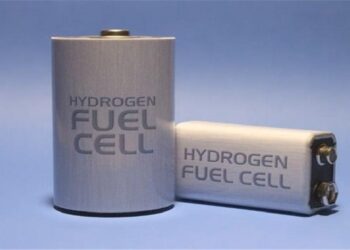A novel solar cell reported this week by researchers at Lawrence Berkeley National Laboratory (LBL) in California selectively cranks out electricity and hydrogen. Panels of these hybrid cells, a novel integration of photovoltaic and electrochemical devices, could simultaneously meet real-time energy demand while socking away hydrogen to back up solar, hydro, and wind generators and to fuel hard-to-electrify equipment such as airplanes.
Yuriy Pihosh, a University of Tokyo research scientist who was not associated with the reported work, calls LBL’s design “simple and innovative.” Pihosh says it could have a “huge impact” on the commercialization of solar hydrogen, which has been one of the holy grails of renewable energy for several decades. In fact, it could be crucial to the transition to carbon-free power that climate scientists say must occur by midcentury to head off the worst impacts of climate change.
What has held solar hydrogen back is the low efficiency of photoelectrochemical (PEC) cells, which split water and release hydrogen gas. Most efforts to date focus on tandem designs, in which PEC cells get a boost from an adjacent PV cell connected in series. However, electrical mismatches and contacts between the PV and PEC devices waste much of the PV cell’s energy, and hydrogen output remains limited.
LBL’s patent-pending design is a single hybrid photoelectrochemical and voltaic (HPEV) cell. The HPEV makes dual use of its photon-excited electrons and thus maximizes its overall efficiency, much as cogeneration power plants achieve high fuel efficiency by squeezing both heat and power from natural gas or coal.
The HPEV cell manages its dual-function feat by adding a third electrode. The PEC electrode atop the device uses as many electrons as it can to produce hydrogen, while dual PV electrodes allow leftover charges to deliver electricity just as they do in standard solar cells.
Putting dual electrical contacts on the HPEV cell’s back face was the key design advance, according to Gideon Segev, an LBL-based postdoc with the U.S. Department of Energy’s Joint Center for Artificial Photosynthesis and lead author on this week’s report in Nature Materials.
Dual back contacts are already well-honed technology applied in high-performance PV panels by San Jose–based Sunpower, where they eliminate the top-face electrode strips that block some light from penetrating into the cells. “It’s well-known stuff. We’re just putting the puzzle pieces together in a different way,” says Segev.
Segev and his colleagues illustrate their design’s energy boost by simulating an HPEV cell using PEC materials that, as Pihosh showed in 2015, can convert 6.8 percent of sunlight to hydrogen. In Segev et al.’s simulation, the HPEV cell turns out the same amount of hydrogen but also converts another 13.4 percent of the available solar energy into electricity—essentially tripling the total energy conversion.
The device should also age gracefully according to Segev, which is important because PEC materials are struggling to match the multidecade robustness of PV materials. (The PEC cells whose efficiency beat Pihosh’s rely on short-lived catalysts and fail within a few days.) Segev says that HPEV cells whose hydrogen output fades should simply produce more power, thus cushioning the loss.
Better still, the HPEV cell can be electrically modulated. “You have a reservoir of charges, and you can choose if you want to direct it to hydrogen production or to electricity, depending on the cost of electricity right now,” says Segev. That functionality could be crucial for 100-percent-renewable power grids such as those that Hawaii’s utilities are mandated to build. When demand surges or wind power falls off, hydrogen cogeneration plants equipped with HPEV cells could boost their power output by half to keep the grid balanced.
The LBL team is now exploring use of the HPEV cell to drive other chemical reactions, including applications that could directly reduce carbon dioxide emissions, according to an LBL press release. But Segev says he hopes other teams will extend the hydrogen work. The LBL team created a small, unoptimized HPEV cell to demonstrate hybrid operation with an efficiency of slightly over 1 percent. He says he is looking forward to other teams producing souped-up hydrogen cells “with the efficiency that it deserves.”







































